Podcast 315: Perfect Roofs, Heated Decks, and Multifamily High Performance
Patrick, Matt, and Brian hear from listeners about lead safety and the right indoor humidity before taking questions on the perfect roof assembly, outdoor snow melting, and rebuilding a wood deck.
Follow the Fine Homebuilding Podcast on your favorite app. Subscribe now and don’t miss an episode:
 |
 |
Help us make better episodes and enter for a chance to win an FHB Podcast T-shirt:
www.finehomebuilding.com/podcastsurvey
Eric tells us about a $20 million fine for violating lead-safety rules. Dan clues us in to a doctor/architect/researcher who focuses on indoor-air quality. Randal wants advice for building the perfect roof assembly. Rob asks about building a heated deck to melt snow. Josh is hoping to save his deck. Nate asks why we aren’t seeing more high-performance multifamily dwellings.
Editor Updates:
- Patrick’s cabinet and drawers
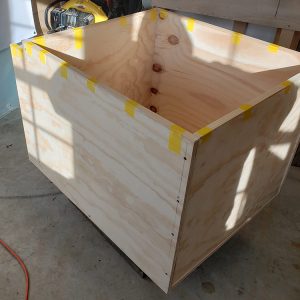 |
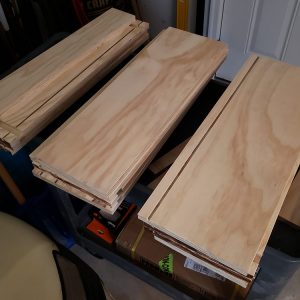 |
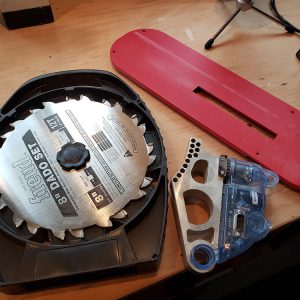 |
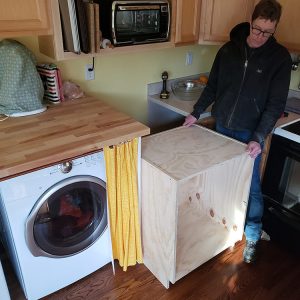 |
Listener Feedback 1:
Eric from Cullowhee, NC writes: It’s a pittance for them, but I suspect it will create increasing $$$ for homeowners who hire contractors to do this right:
FROM CBS Boston: Home Depot will pay a fine of more than $20 million after settling with the Environmental Protection Agency and the Department of Justice for alleged “serious violations” of the EPA’s lead paint rule. The company will also pay Massachusetts $732,000 as part of the settlement.
It’s the largest penalty ever paid under the Toxic Substances Control Act, according to federal officials. The agencies said Home Depot gave work to subcontractors that in some cases did not use lead-safe practices or do required post-renovation cleaning, among other violations. There were also instances where Home Depot did not make sure contractors performing renovations were property trained in lead safety.
Related Links:
- Lead-Paint Safety, at Home and on the Job
- EPA’s Lead-based Paint Enforcement Helps Protect Children and Vulnerable Communities
Listener Feedback 2:
Dan writes: Hey FHB team, In episode 309 you were talking about humidity and a HRV. At sub 40% humidity I believe you should be running the humidifier. Yes the HRV and humidifier “work against” each other, but with that way of thinking so does your HRV and furnace, yet we don’t turn off our furnace.
Each one is accomplishing a separate tasks to balance a different element of a comfortable and healthy environment. I recommend listening to the Building HVAC Science episode #48 to learn about the effects of low humidity on our health.
Love listening to everyone
Related Links:
Listener Feedback 3:
Jim writes: I escaped California a few years ago after my county became a major “growing” area. Typically, once a house has been used as a “grow” house, it has to have the drywall removed and a full mold remediation done before it’s habitable. After an entire season of being held at 80-90 degrees and nearly 100% humidity, the walls are covered in mold that extends deep into the drywall. A seller can mask this with a few coats of paint but it’ll come back until a serious assault is done on it.
Also, these growers only care about money and often use excessive amounts of toxic chemicals to force the growth and they don’t have much concern about spillage or clean up. Often this means the floors need to be removed which is problematic when it’s a slab.
When the Sheriff raids them, they go in wearing full hazmat garb for a good reason.
Put as much distance between you and a “grow” house as you can.
Related Links:
- Restoring And Decontaminating Former Marijuana Grow Houses
- I Accidentally Bought a Marijuana Grow House: Why Even Weed Lovers Should Be Very Afraid
Question 1: What’s the “perfect” way to build and insulate a roof?
Randall from Facebook writes: I’ve got a lot of good advice from you folks regarding the perfect wall, air sealing, vapor barriers, and wall insulation, but how about the perfect roof? Did I miss that article? I’d like to see more on roof insulation, combining cavity fill and continuous exterior insulation. Can you direct me to those articles? Thanks.
Related Links:
- An Unvented, Superinsulated Roof
- What’s the Best Attic Insulation?
- Roof Venting Done Right
- How to Build an Insulated Cathedral Ceiling
- Five Cathedral Ceilings That Work
Question 2: How can I heat a deck to keep snow off of it?
Rob writes, Hi FHB crew, I’m a fairly experienced weekend warrior and regular taker of architecture classes at my local community college and very much appreciate the education I’ve received over the years from the podcast and magazine. Always fun in class to throw out the occasional “don’t you guys read Fine Homebuilding?” and bask in the brief but satisfying superiority that accompanies that statement, so thanks for that as well. I’ve now gotten bored enough to rip up my front just above ground level deck and reconfigure it. I would like to do a heated tile section extending approx. 10×15 ft in front of the door so I don’t have to shovel snow anymore but am finding very limited options. I would be framing out the deck structure (about 1 ft above ground) rather stoutly and then tiling with a method I read about at JLC shown here: Tiling a Deck
Related Links:
Question 3: Can I Reuse the Framing When Rebuilding My Failing Deck?
Josh writes, Dear FHB crew, The boards on my 56’x16′ deck are in need of replacement. The rest of the deck is in OK shape, and I’d like to avoid a full rebuild right now. It would be ideal if I could resurface the deck DIY, and get another 10 years out of it before the structure needs to be replaced. However, I foresee a few problems and would appreciate your thoughts on my solutions.
Problem #1: The tops of the joists are split and rotted at the butt joints, leaving nothing for new fasteners to grab onto.
Solution #1: Sister a 2×4 to each joist, in order to provide a nailer for the deck boards. Cap both the old board and 2×4 with 6″ wide peel-and-stick flashing.
Problem #2: The deck ledger was never flashed. The vertical toung-and-groove cedar siding is sandwiched in between the ledger and rim board. The gaps between the siding and trim were filled with caulk, which is failing.
Solution #2: Remove the existing trim, cut a few inches of siding out, and tuck a piece of z-flashing behind the siding, which would go over top of the deck ledger. Unfortunately, I think I’ll have to leave the old siding sandwiched between the ledger and the rim board.
Problem #3: Several of the footings are covered in soil, and the posts are starting to rot at the bottom.
Solution #3: Remove the soil, install Simpson RZBP retrofit post bases for added security. Optionally, cut off the bottom 1″ of post, and install a plastic spacer to separate the post from the concrete.
Is this a reasonable plan?
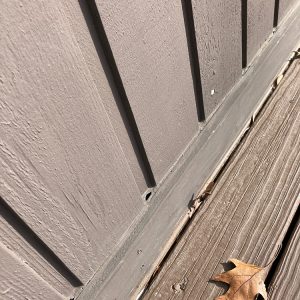 |
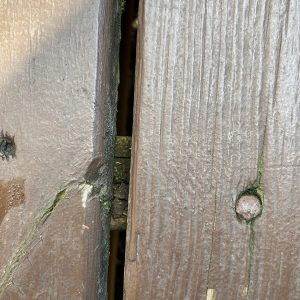 |
 |
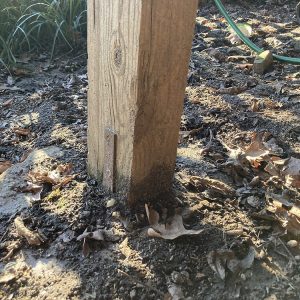 |
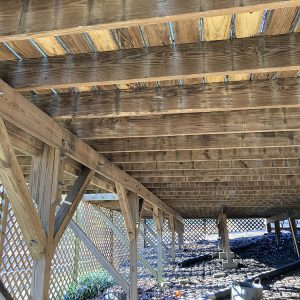 |
Related Links:
Question 4: Why aren’t we building more multi-family Passive House buildings?
Nate writes, Hello to the wonderful folks of the FHB Podcast, I’ve been an avid listener to the show for a couple years now. I started listening while working in St. Thomas as a construction site supervisor/project coordinator for a non-profit. We rebuilt roofs and homes after hurricanes Irma and Maria, while also living on a Caribbean Island, which wasn’t so bad.
I’m a mathematician and physicist by degree, engineer by title, and closeted building-science nerd. A coworker of mine just moved into a brand-new apartment complex here and Kansas City, that has claimed to be the largest Passive House building in the world. After seeing the apartment, it is quite impressive. I was helping him bring a TV in the other day and completely nerded out on the building. It has 16″ exterior walls with 4″ concrete, 6″ continuous foam insulation and 6″ of concrete, triple-glazed windows, ERVs, solar… the nerd list goes on. The rent on a one bedroom is $1500/month which is almost identical to a building adjacent that isn’t passive. This makes me wonder is there a significant, untapped, economy of scale when it comes to building passive?
https://www.secondanddelaware.com/content/design
Anyway, thought it was worth sharing and maybe worth a discussion of why we aren’t seeing more of these multi-family passive houses. (bit of a misnomer)
Keep fighting the good fight, Nate.
Related Links:
- Second + Delaware is the World’s Largest Passive House Building
- A Better Path to a Low-Carbon Future?
- Chris Magwood: What is the Carbon Elephant in the Room?
Podcast Theme of The Month:
“Tools, and How to Use Them”
Visit the Taunton Store • Magazine Index • Online Archive • Our First Issues • All Access
Help us make better episodes and enter for a chance to win an FHB Podcast T-shirt: www.finehomebuilding.com/podcastsurvey
If you have any questions you would like us to dig into for a future show, shoot an email our way: fhbpodcast@taunton.com.
If we use your question we’ll send you a FHB Podcast sticker!
FHB Podcast T-shirts!
Represent your favorite podcast! Available in several styles and colors. Made from 100% cotton. Find the Podcast t-shirt and more cool products in the Fine Homebuilding Store.
This episode of the Fine Homebuilding podcast is brought to you by BuildBook.
Happy Clients. More Profits. Less Stress. That’s the trifecta of the construction business. We all want that, right? Well, after working and talking with 100’s of home builders and remodelers over the past 2 years, BuildBook has discovered the one common ingredient that determines the success of your construction business…the client experience.
Yes, if you drop the ball anywhere in the client experience from the first impression to the final payment, things can get super messy super quickly.
BuildBook has spent the past several months developing the first-of-its-kind platform that focuses on helping you deliver throughout the client journey the one thing standing between you and achieving the trifecta of construction.
It starts with marketing tools to attract the right leads. Add in sales tools so you can win the best projects. And finish with project tools that knock your clients socks off!
If you’re looking for an unfair advantage in your business, this is it. Head on over to BuildBook.co now to try it free for yourself.
Visit BuildBook.co for more.
Also brought to you by Protective Products
Protective Products, the nation’s oldest, most trusted, direct-to-you supplier of Surface Protection and Dust Control. From industry-leading Econo Runner, protection for most hard flooring, to Zipwall, the contractor’s choice for building quick containment areas, Protective Products works with you to keep your jobsites protected and your customers happy. Show that you care about preserving your quality craftsmanship with their full line of Surface Protection and Dust Control Solutions, see it all at ProtectiveProducts.com.
Fine Homebuilding podcast listeners can now get 20% off anything in the Taunton store, including Insulate & Weatherize.
Use the discount code FHBPODCAST to take advantage of this special offer.
We hope you will take advantage of a great offer for our podcast listeners: A special 20% off the discounted rate to subscribe to the Fine Homebuilding print magazine. That link goes to finehomebuilding.com/podoffer.
The show is driven by our listeners, so please subscribe and rate us on iTunes or Google Play, and if you have any questions you would like us to dig into for a future show, shoot an email our way: fhbpodcast@taunton.com. Also, be sure to follow Fine Homebuilding on Instagram, and “like” us on Facebook. Note that you can watch the show above, or on YouTube at the Fine Homebuilding YouTube Channel.
The Fine Homebuilding Podcast embodies Fine Homebuilding magazine’s commitment to the preservation of craftsmanship and the advancement of home performance in residential construction. The show is an informal but vigorous conversation about the techniques and principles that allow listeners to master their design and building challenges.
Other related links
-
- All FHB podcast show notes: FineHomebuilding.com/podcast.
- #KeepCraftAlive T-shirts and hats support scholarships for building trades students. So order some gear at KeepCraftAlive.org.
- The direct link to the online store is here.

































View Comments
Podcast 315
The guys were wondering who will end up paying the HD fine for ignoring lead rules. Just a guess but I'd bet the settlement was paid by their insurance. It would be common for the insurer to try to recover from the wayward contractors, but it would be hard to find a contractor that long-lived and with the funds to make such an effort worthwhile. The insurance company's unrecoverable claim probably ends up as a tax write off absent some prohibition against writing off administrative fines.